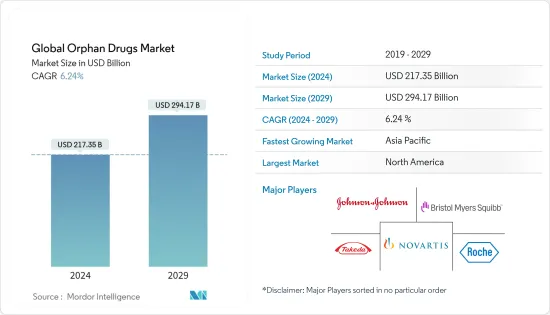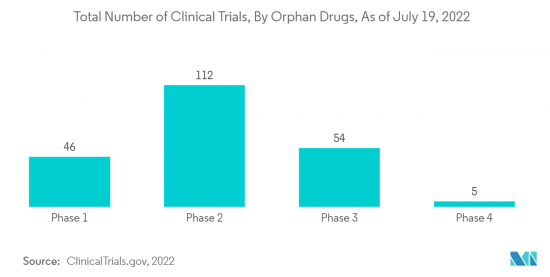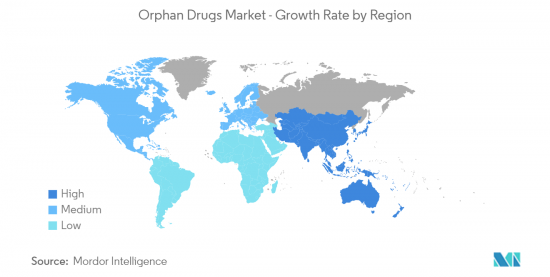
희귀의약품 세계 시장 규모는 2024년 2,173억 5,000만 달러로 추정되며, 2029년에는 2,941억 7,000만 달러에 달할 것으로 예상되며, 예측 기간(2024-2029년) 동안 6.24%의 CAGR을 기록할 것으로 예상됩니다.

COVID-19는 전례 없는 공중보건 문제이며, 사회적 배제로 인해 병원과 의료 서비스가 심각하게 제한되고 공급망에 큰 영향을 미쳐 세계 희귀의약품 시장에 큰 영향을 미치고 있습니다. 2020년 9월, 미국 식품의약국(FDA)은 코로나19를 희귀질환으로 취급하는 것은 '불성실'하다는 비판에 따라 길리어드 사이언스의 코로나19 치료제 후보물질에 대한 희귀질환 치료제 지정을 취소했습니다. 이러한 사례는 팬데믹 상황에서 시장 성장을 저해할 수 있는 요인으로 작용할 수 있습니다. 이처럼 팬데믹은 조사 대상 시장에 큰 영향을 미칠 것으로 예상됩니다.
이 시장의 성장 요인으로는 희귀의약품 개발 기업에 대한 시장 독점권, 희귀질환 신흥국 시장 개척, 유리한 정부 정책 등을 꼽을 수 있습니다.
최근 몇 년 동안 전 세계 인구의 희귀질환 유병률이 증가하고 있습니다. 이 문제를 해결하기 위해 신흥국과 선진국 모두 희귀의약품 개발을 촉진하고 환자가 쉽게 이용할 수 있도록 규정을 마련하고 있으며, 2022년 5월 GARD(Genetic and Rare Diseases) 정보 센터에 따르면 미국인 10명 중 1명(3,000만 명)이 희귀질환을 앓고 있으며, 약 7,000개의 희귀질환이 알려져 있습니다. 또한 GlobalGenes가 2021년 9월에 업데이트한 데이터에 따르면, 전 세계적으로 4억 명 이상이 희귀질환의 영향을 받고 있습니다. 희귀질환의 80%는 유전학적 기원이 확인된 것으로 나타났습니다. 또한 2022년 3월에 발표된 '희귀질환: 모멘텀 유지'라는 제목의 연구에 따르면, 2021년 제약사들이 희귀질환 연구에 지출한 총액은 229억 달러로 2020년 대비 28% 증가했습니다. 이처럼 희귀질환에 대한 유병률 증가와 연구개발비 증가는 혁신적인 희귀의약품에 대한 기회를 제공하고 있습니다. 따라서 분석 기간(2022-2027년) 동안 시장 성장을 촉진할 것으로 예상됩니다.
또한, 희귀의약품 승인 및 생산에 대한 정부의 우호적인 정책도 시장 성장을 뒷받침하고 있습니다. 희귀의약품법(ODA)이 잘 시행되고 있는 국가로는 미국, 일본, 호주, 유럽 등이 있습니다. 국민의 약 99%가 건강보험에 가입되어 있는 일본은 최근 희귀의약품 기준을 5만 명 미만에서 18만 명 미만으로 확대하여 환자, 지불자, 의료 제공자에게 희귀질환에 대한 성공 기회를 제공하고 있습니다. 유럽에서는 유럽의약품청(EMA)이 희귀의약품 개발 및 허가를 촉진하는 핵심 기관입니다. 최근 5년간 승인 건수는 EU 전체에서 지속적으로 높은 수준을 유지하고 있습니다.
또한, 희귀질환에 대한 새로운 치료법을 개발하기 위한 연구개발 활동이 활발해지면서 시장 성장에 힘을 보태고 있습니다. 예를 들어, 2021년 12월 ClinicalTrails.gov에 따르면, Assistance Publique-Hopitaux de Paris가 진행 중인 '희귀질환 환자의 구강 건강 관련 삶의 질: 질적 접근(RaroDentAXE3)'이라는 제목의 연구는 2022년 12월까지 완료될 예정입니다. 이처럼 희귀질환에 대한 연구가 증가함에 따라 예측 기간 동안 시장 성장을 촉진할 것으로 예상됩니다.
이러한 모든 요인들이 예측 기간 동안 시장 성장을 촉진할 것으로 예상됩니다. 그러나 임상시험 및 마케팅에 필요한 환자 수가 제한적이어서 시장 성장을 억제하는 요인으로 작용하고 있습니다.
신경질환은 희귀질환의 약 절반을 차지합니다. 선별검사, 유전체 염기서열 진단, 전문 임상 지식이 부족해 희귀 중추신경계(CNS) 질환의 식별과 치료가 어려운 경우가 많습니다. 희귀질환은 약 5,000-8,000여 종에 달합니다. 신경질환에는 반사성 교감신경이영양증 증후군, 바타유라 넬리 증후군, 크로이츠펠트 야콥병, 실인증, 아이카르디 증후군, 아이카르디-구티에레 증후군 등이 있습니다. 2022년 1월에 발표된 '희귀질환의 유병률과 발생률: 서지 데이터'라는 제목의 보고서에 따르면, 만성 염증성 탈수초성 다발성 신경병증의 유병률은 유럽에서 3.7로 나타났습니다. 그러나 희귀 신경 질환의 진단에는 희귀 신경 질환에 대한 주민들의 인식 부족 등 몇 가지 장벽이 있습니다. 희귀질환은 전 세계적으로 막대한 의료 및 경제적 부담을 초래하고 있습니다.
2020년 6월에 업데이트된 미국 희귀질환기구(NORD)의 데이터에 따르면, 7,000개 이상의 희귀질환이 존재하며, 3,000만 명 이상의 미국인이 앓고 있는 것으로 추정됩니다. 또한, 이 중 약 1/3은 신경학적 요소나 증상을 동반하는 것으로 알려져 있습니다. 또한, 2021년 1월 희귀 신경질환 연구센터가 발표한 자료에 따르면, 희귀 신경질환은 미국에서 약 20만 명에게 영향을 미치고 있습니다. 이처럼 희귀 신경질환의 부담 증가는 희귀의약품 수요를 증가시키는 요인으로 작용하고 있습니다.
2021년 7월 Orphanet of the Rare Diseases에 게재된 '희귀의약품 개발 동향을 설명하기 위한 FDA의 40년간 희귀의약품 지정: 희귀 종양질환, 신경질환, 소아 발병 질환 치료제 개발의 큰 성장'이라는 제목의 연구 결과에 따르면에 따르면, 희귀의약품 지정의 상위 3개 치료 카테고리는 종양(1910건, 37%), 신경(674건, 13%), 감염(436건, 9%)으로 나타났습니다.
또한, 희귀의약품에 대한 미국 식품의약국(FDA)의 승인 확대는 이 부문의 성장을 촉진할 것으로 예상됩니다. 예를 들어, 2021년 11월 파마테르 홀딩스(PharmaTher Holdings Ltd.)는 발작에 대한 긴급 치료가 필요한 희귀 신경질환인 간질 치료를 위한 케타민에 대해 희귀의약품 지정('ODD')을 받을 예정입니다.
앞서 언급한 모든 요인들이 예측 기간 동안 이 분야의 성장을 촉진할 것으로 예상됩니다.

북미 지역은 현재 희귀의약품(희귀의약품) 시장을 독점하고 있으며, 앞으로도 그 아성은 흔들리지 않을 것으로 예상됩니다. 북미 지역에서는 미국이 가장 큰 시장 점유율을 차지하고 있습니다. 미국에서는 희귀의약품으로 지정된 의약품은 특정 적응증에 대해 FDA의 승인을 받으면 7년간 판매 독점권, 세액공제 및 사용료 면제를 받을 수 있는데, 이것이 시장 성장의 이유 중 하나입니다.
또한 유전성 희귀질환 정보센터(GARD)가 2022년 5월에 업데이트한 데이터에 따르면 희귀질환은 약 3,000만 명의 미국인에게서 발견되며, 캐나다 희귀질환기구(CORD)의 2021년 업데이트된 데이터에 따르면 310만 명의 캐나다인에게서 발견됩니다. 미국에서는 유병률이 높기 때문에 정부는 연구 보조금과 기금을 통해 희귀 질환 환자를 지원하고 있으며, FDA가 승인한 치료법이 있는 희귀 질환은 5%에 불과하기 때문에 NIH는 2019년부터 2020년까지 희귀 질환 연구를 위해 3,100만 달러의 보조금을 제공했습니다. 마찬가지로 2020년 10월 미국 식품의약국(FDA)은 희귀의약품법을 시행하여 향후 4년간 6건의 임상시험 연구를 위해 산업계와 학계에 1,600만 달러 이상을 지원했습니다.
또한, 희귀의약품으로 지정된 의약품의 증가는 시장 성장을 촉진할 것으로 예상됩니다. 예를 들어, 2020년 6월 Agios Pharmaceuticals Inc.는 미국 식품의약국(FDA)으로부터 자사의 혈우병 치료제 미타피바트(Mitapivat)를 희귀의약품으로 지정받았으며, 2020년 5월에는 아스트라제네카(AstraZeneca)와 다이이찌산쿄(Daiichi Sankyo)가 위암 및 식도 접합부 암 환자를 위한 위암 치료제 엔헬투(Trastuzumab)를 개발했습니다. 식도 접합부 암을 포함한 위암 환자를 대상으로 한 엔헬투(성분명: 트라스투주맙 데렉스테칸)가 미국 식품의약국(FDA)으로부터 희귀의약품 지정을 받았습니다.
이러한 이유로 희귀의약품 시장은 북미 지역에서 성장할 것으로 전망되고 있습니다.

희귀의약품 시장의 경쟁은 중간 정도입니다. 시장 점유율 측면에서 현재 소수의 대기업이 시장을 독점하고 있습니다. 질병 수가 증가하고 매년 환자 수가 증가함에 따라 소수의 중소기업이 시장에 진입하여 상당한 점유율을 차지하고 있습니다. 시장 진입 기업으로는 Celgene Corporation, Takeda Pharmaceutical Company Limited, Novartis AG, Johnson & Johnson, F. Hoffmann-La Roche Ltd 등이 있습니다.
The Global Orphan Drugs Market size is estimated at USD 217.35 billion in 2024, and is expected to reach USD 294.17 billion by 2029, growing at a CAGR of 6.24% during the forecast period (2024-2029).

The COVID-19 outbreak is an unprecedented public health concern that has had a significant impact on the orphan drug market globally as hospital and healthcare services were severely curtailed due to social exclusion and the supply chain was hampered. In September 2020, following criticism that treating covid-19 as a rare disease was "disingenuous," the United States Food and Drug Administration (FDA) has withdrawn orphan drug designation from a potential treatment for covid-19 from Gilead Science. Such instances may hamper the market growth during the pandemic. Thus, the pandemic is anticipated to have a significant impact on the studied market.
Some of the factors that are responsible for the growth of this market include market exclusivity for orphan drug developers, the rising prevalence of rare diseases, and favorable government policies.
Globally, the prevalence of rare diseases among the global population has been increasing in recent years. To tackle this issue, both developing and developed countries have formulated regulations that promote the development of drugs for rare diseases, as well as make sure that these drugs are easily availRare diseases: maintaining momentumable to patients. According to the Genetic and Rare Diseases (GARD) Information Center in May 2022, 1 in 10 Americans (or 30 million people) have a rare disease, and there are approximately 7,000 known rare diseases. Moreover, as per data updated in September 2021 by the "GlobalGenes", more than 400 million people worldwide are impacted by rare diseases. 80% of rare diseases have been identified with genetica origins. Moreover, as per the study titled "Rare diseases: maintaining momentum" published in March 2022, drug companies spent USD 22.9 billion in total in research on rare disorders in 2021, a 28% growth from 2020. Thus, growing prevalence and increasing research and development spending on rare diseases are creating opportunities for innovative orphan drugs. Thus, is expected to boost the market growth over the analysis period (2022-2027).
Additionally, favorable government policies for orphan drug approval and production support the market growth. Some of the countries with the well-recognized orphan drug act (ODA) include the United States, Japan, Australia, and Europe. Japan, with its health insurance for approximately 99% of its citizens, recently expanded its orphan drug criteria from less than 50,000 patients to less than 180,000 patients, to provide more opportunities for patients, payers, and providers, to achieve success against orphan diseases. In Europe, the European Medicines Agency (EMA) is the central organization related to facilitating the development and authorization of medicines for rare diseases. The approvals have been consistently high in the recent five years, across the European Union.
Furthermore, increasing research and development activities in the development of new therapies for rare diseases is also boosting the market growth. For instance, According to ClinicalTrails.gov in December 2021, a study titled "Oral Health-Related Quality of Life of Patients With Rare Diseases: a Qualitative Approach (RaroDentAXE3)" under the investigation from Assistance Publique - Hopitaux de Paris is expected to be completed by December 2022. Thus, the rising number of studies on rare diseases is anticipated to boost the market growth over the forecast period.
Thus, all aforementioned factors are expected to boost the market growth over the forecast period. However, a limited patient pool for clinical trials and marketing restraint the market growth.
Neurological disorders make up nearly half of these rare diseases. Due to the lack of screening tests, diagnostic genomic sequencing, and specialized clinical expertise, rare central nervous system (CNS) disorders are frequently challenging to identify and treat. There are about 5,000-8,000 rare diseases. Some neurological disorders include reflex sympathetic dystrophy syndrome, Battaglia-Neri syndrome, Creutzfeldt Jakob Disease, agnosia, Aicardi syndrome, and Aicardi-Goutieres syndrome. As per the report titled "Prevalence and incidence of rare diseases: Bibliographic data", published in January 2022, the prevalence of chronic inflammatory demyelinating polyneuropathy is 3.7 in Europe. However, the diagnosis of rare neurological diseases involves several barricades, such as a lack of awareness about rare neurological diseases within the population. Rare diseases are creating huge healthcare and economic burden worldwide.
The National Organization for Rare Disorders (NORD) data updated in June 2020 estimates that there are more than 7,000 rare diseases that are affecting more than 30 million Americans. In addition, about one-third of these are thought to include neurological components and symptoms. Additionally, as per the data published by the Center for Rare Neurological Disease Research in January 2021, rare neurological diseases affect approximately 200,000 individuals in the United States. Thus, the growing burden of rare neurological diseases drives the demand for orphan drugs.
According to the study titled "Using four decades of FDA orphan drug designations to describe trends in rare disease drug development: substantial growth seen in the development of drugs for rare oncologic, neurologic, and pediatric-onset diseases" published in the Orphanet of the Rare Diseases in July 2021, oncology (1910, 37%), neurology (674, 13%), and infectious diseases (436, 9%) were the top three therapeutic categories represented in the orphan drug designations.
Moreover, the growing approval of the Food and Drug Administration (FDA) for the orphan drug is anticipated to boost the segment growth. For Instance, in November 2021, PharmaTher Holdings Ltd. to receive Orphan Drug Designation ('ODD') for ketamine to treat Status Epilepticus, a rare neurological disorder requiring emergency treatment for a seizure.
Thus, all aforementioned factors are expected to boost the segment growth over the forecast period.

North America currently dominates the market for orphan drugs and is expected to continue its stronghold for a few more years. In the North American region, the United States holds the largest market share. One of the reasons for market growth is that in the United States, a drug-designated orphan drug status receives seven years of marketing exclusivity upon FDA approval for a specific indication, tax credits, and user fee waiver.
Furthermore, rare diseases are found in around 30 million Americans, according to data updated in May 2022 by the Genetic and Rare Diseases Information Center (GARD), and 3.1 million Canadians, according to the Canadian Organization for Rare Disorders (CORD) 2021 update. Due to the high prevalence in America, the government has provided support for patients with rare diseases through research grants and funds. With only 5% of rare diseases having FDA-approved treatment, the NIH has provided USD 31 million in grants to study rare diseases between 2019 and 2020. Similarly, in October 2020, the Food and Drug Administration (FDA) carried out the Orphan Drug Act and awarded over USD 16 million for six clinical trial research studies to industry and academia for the next four years.
Moreover, a growing number of drugs with the orphan drug designation is anticipated to boost the market growth. For instance, in June 2020, Agios Pharmaceuticals Inc., received the United States Food and Drug Administration (FDA) orphan drug designation for their pipeline candidate of Mitapivat for the treatment of Thalassemia. In May 2020, AstraZeneca Plc and Daiichi Sankyo Company received United States Food and Drug Administration (FDA) orphan drug designation for Enhertu (Trastuzumab deruxtecan) for the treatment of patients with gastric cancer, including gastroesophageal junction cancer.
Therefore, owing to the factors mentioned above the orphan drugs market is anticipated to grow in the North American region.

The orphan drugs market is moderately competitive. In terms of market share, a few of the major players currently dominate the market. With the rising number of diseases and an increasing number of cases each year, a few smaller players are entering the market and holding a substantial share. Some of the market players include Celgene Corporation, Takeda Pharmaceutical Company Limited, Novartis AG, Johnson & Johnson, F. Hoffmann-La Roche Ltd and others.